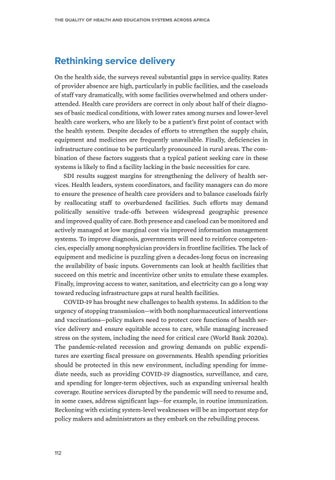The Quality of Health and Education Systems Across Africa
Rethinking service delivery On the health side, the surveys reveal substantial gaps in service quality. Rates of provider absence are high, particularly in public facilities, and the caseloads of staff vary dramatically, with some facilities overwhelmed and others underattended. Health care providers are correct in only about half of their diagnoses of basic medical conditions, with lower rates among nurses and lower-level health care workers, who are likely to be a patient’s first point of contact with the health system. Despite decades of efforts to strengthen the supply chain, equipment and medicines are frequently unavailable. Finally, deficiencies in infrastructure continue to be particularly pronounced in rural areas. The combination of these factors suggests that a typical patient seeking care in these systems is likely to find a facility lacking in the basic necessities for care. SDI results suggest margins for strengthening the delivery of health services. Health leaders, system coordinators, and facility managers can do more to ensure the presence of health care providers and to balance caseloads fairly by reallocating staff to overburdened facilities. Such efforts may demand politically sensitive trade-offs between widespread geographic presence and improved quality of care. Both presence and caseload can be monitored and actively managed at low marginal cost via improved information management systems. To improve diagnosis, governments will need to reinforce competencies, especially among nonphysician providers in frontline facilities. The lack of equipment and medicine is puzzling given a decades-long focus on increasing the availability of basic inputs. Governments can look at health facilities that succeed on this metric and incentivize other units to emulate these examples. Finally, improving access to water, sanitation, and electricity can go a long way toward reducing infrastructure gaps at rural health facilities. COVID-19 has brought new challenges to health systems. In addition to the urgency of stopping transmission—with both nonpharmaceutical interventions and vaccinations—policy makers need to protect core functions of health service delivery and ensure equitable access to care, while managing increased stress on the system, including the need for critical care (World Bank 2020a). The pandemic-related recession and growing demands on public expenditures are exerting fiscal pressure on governments. Health spending priorities should be protected in this new environment, including spending for immediate needs, such as providing COVID-19 diagnostics, surveillance, and care, and spending for longer-term objectives, such as expanding universal health coverage. Routine services disrupted by the pandemic will need to resume and, in some cases, address significant lags—for example, in routine immunization. Reckoning with existing system-level weaknesses will be an important step for policy makers and administrators as they embark on the rebuilding process.
112


